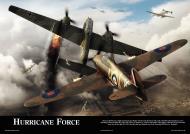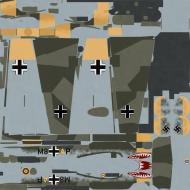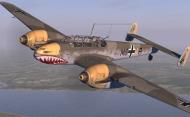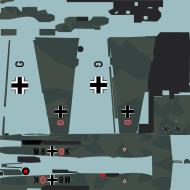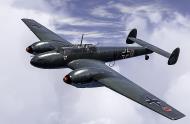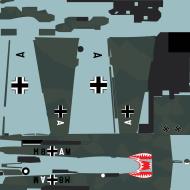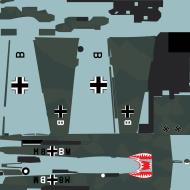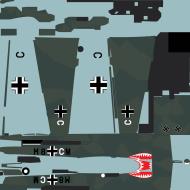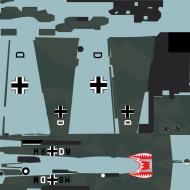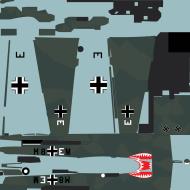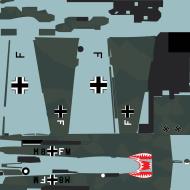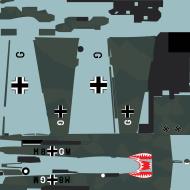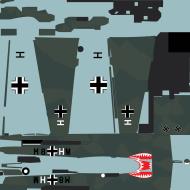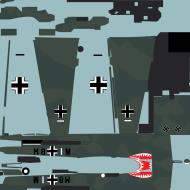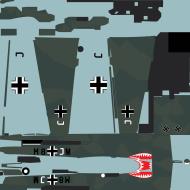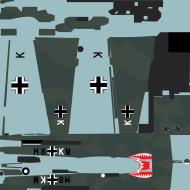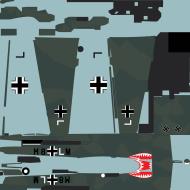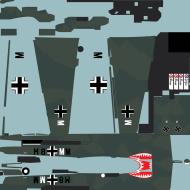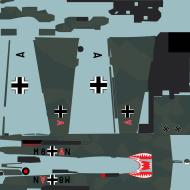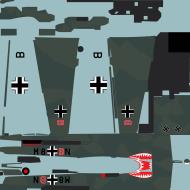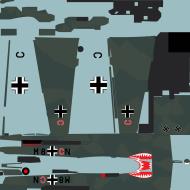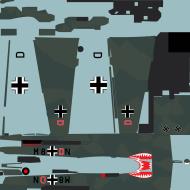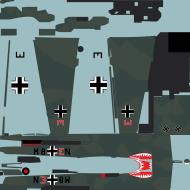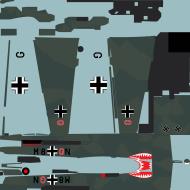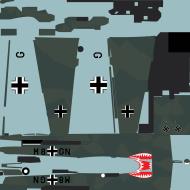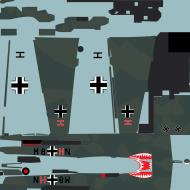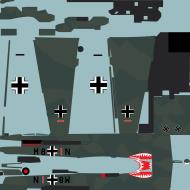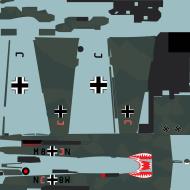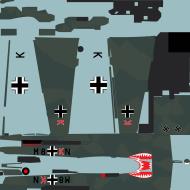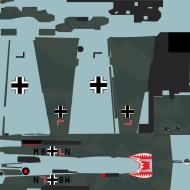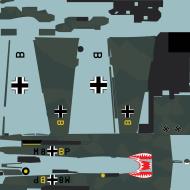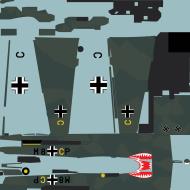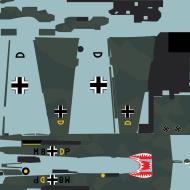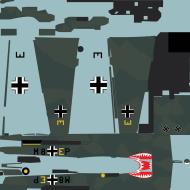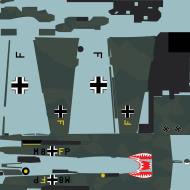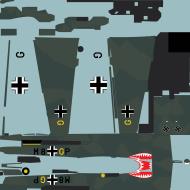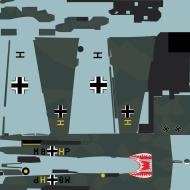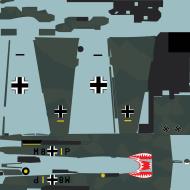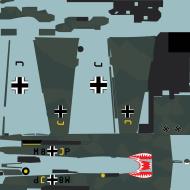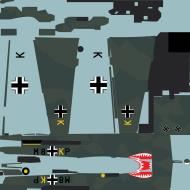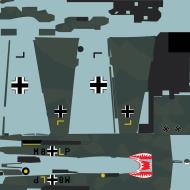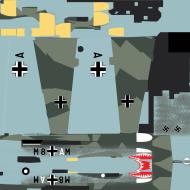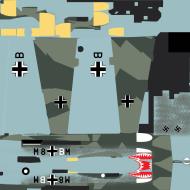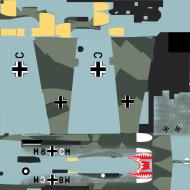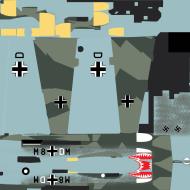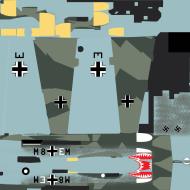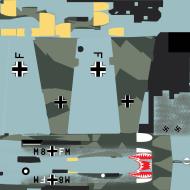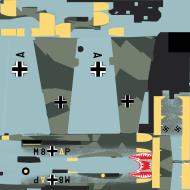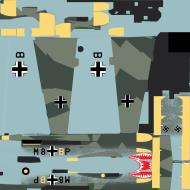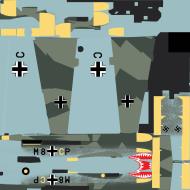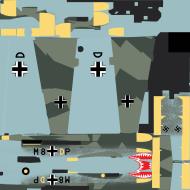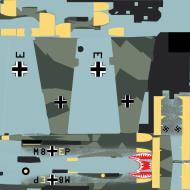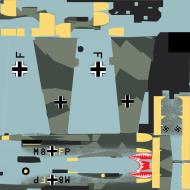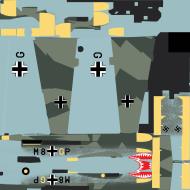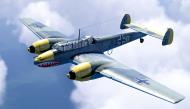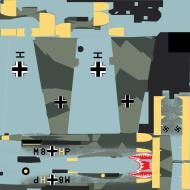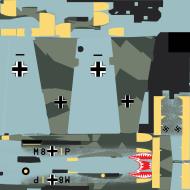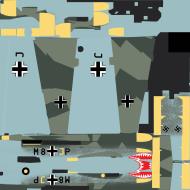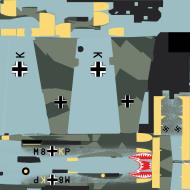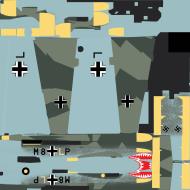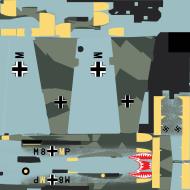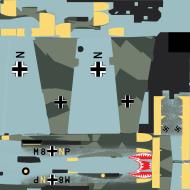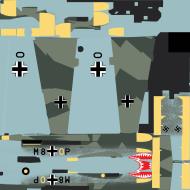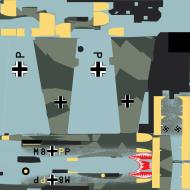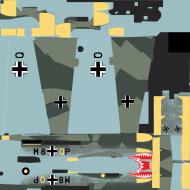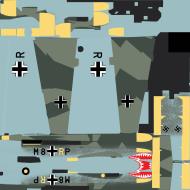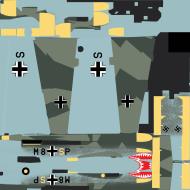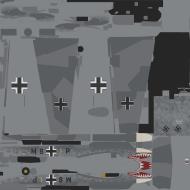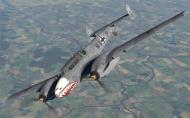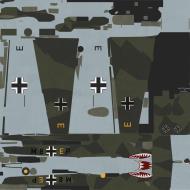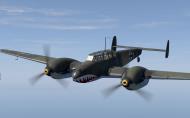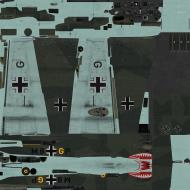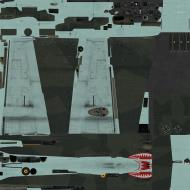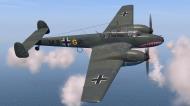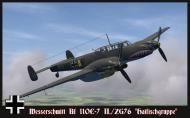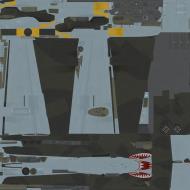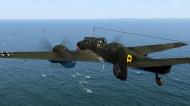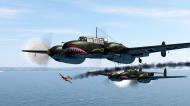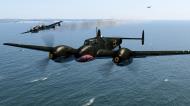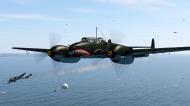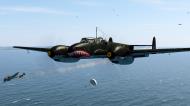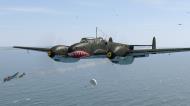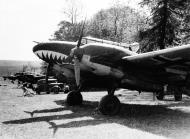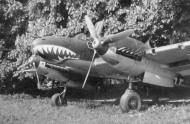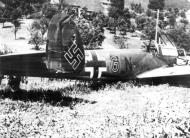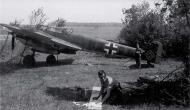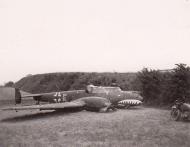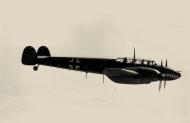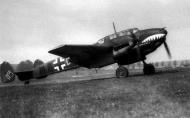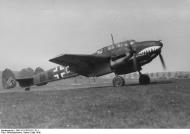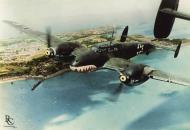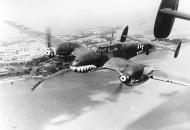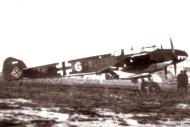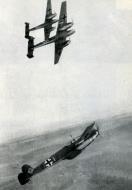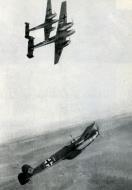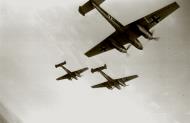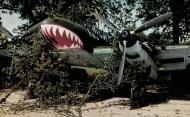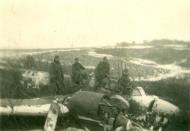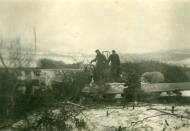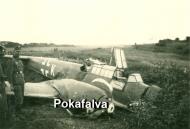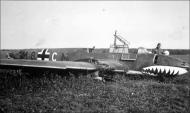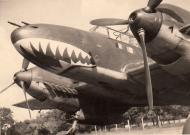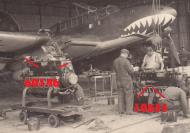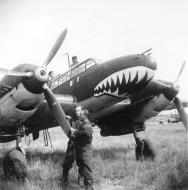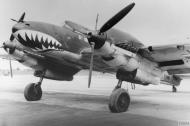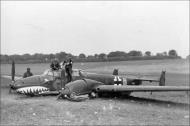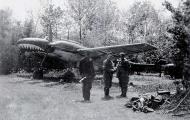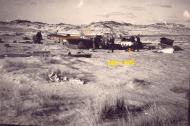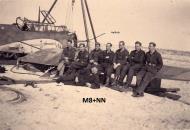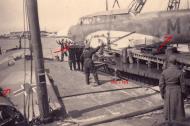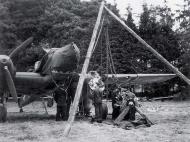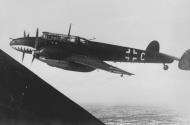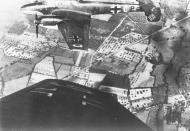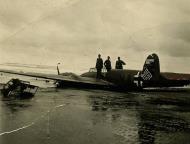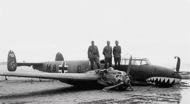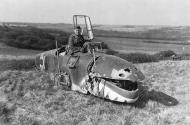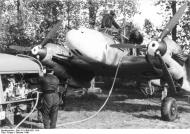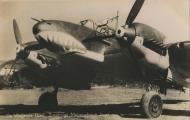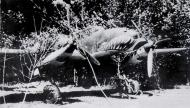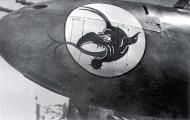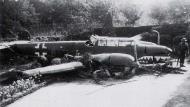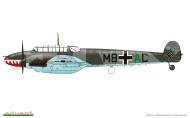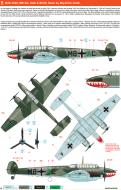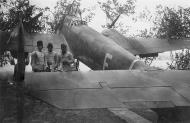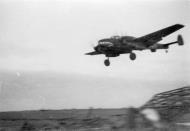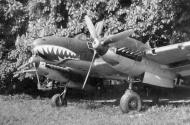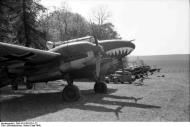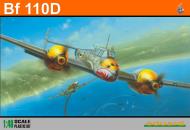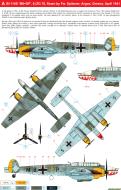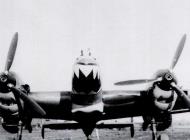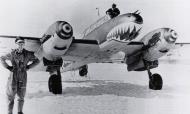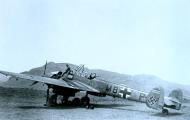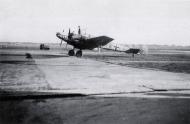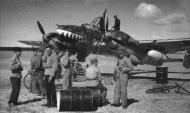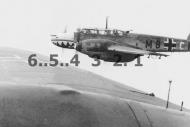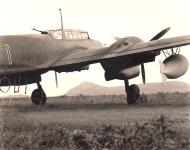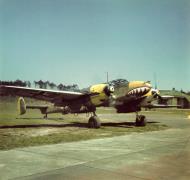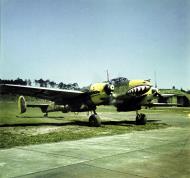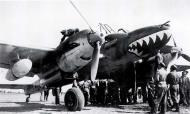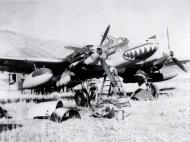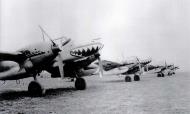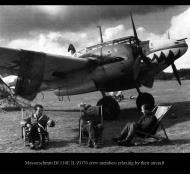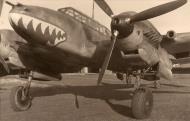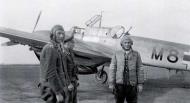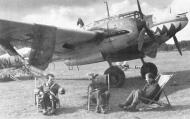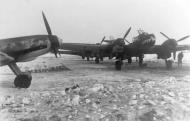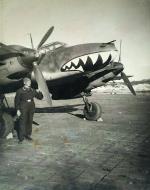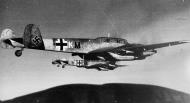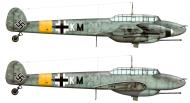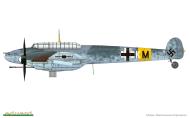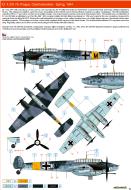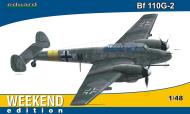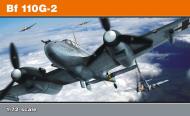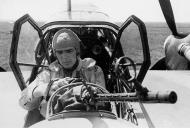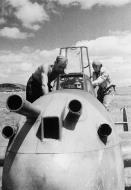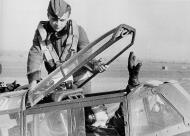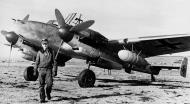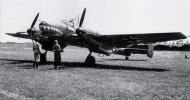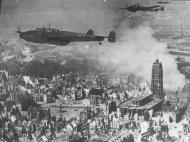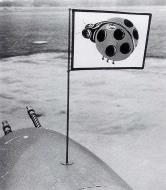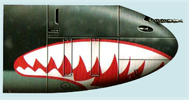
II Gruppe Zerstörergeschwader 76- II./ZG76
Messerschmitt Bf 110C Zerstorer 4./ZG76 (M8MM) Ofw Anthony and Uffz Nordmeier Werk Nr 3615 France 1940 0A
Messerschmitt Bf 110D3 Zerstorer 6./ZG76 (M8SP) Heinrich Spitzner Argos Greece Apr 1941 SAMI 2013 07
Messerschmitt Bf 110E Zerstorer 5./ZG76 (M8AN) Haifischgruppe shark group Magdeburg East enhanced photo
II. Gruppe Zerstörergeschwader 76
4. Staffel II. Gruppe Zerstörergeschwader 76 - 4./ZG76 coded M8+
Messerschmitt Bf 110C Zerstörer 4./ZG76 (M8+CM) crash landing 01
Photo 01: M8+CM belly-landed by an unknown pilot, Note the first style fully-enclosed Bordfunker's central rear canopy.
Messerschmitt Bf 110C Zerstörer 4./ZG76 (M8+CM) Martin Drewes France 1940
Messerschmitt Bf 110G Zerstörer 3./NJG1 (G9+WD) pilot Martin Drewes 01
Photo 01: Major Martin Drewes, the Kommandeur of III./NJG1 (Left) with his crew shortly after his 47th victory, a Lancaster, which he shot down in the early hours of 3 March 1945. Drewes flew two Bf 110s, the one in the background here being G9+WD which earlier, in January 1944, when night fighter crews were ordered to attack US bombers in daylight, had been stripped of its radar and 20 mm cannon pack beneath the fuselage in order to increase its speed. In these daylight attacks, Drewes destroyed four US bombers, but for night work he flew his other Bf 110G-4, G9+MD, which retained its radar but had no victory markings. The G9+MD was eventually destroyed when the bomb load of a bomber attacked with 'Schrage Musik' exploded and debris so severely damaged Drewes' Bf 110 that the crew were forced to bale out. Thereafter, the G9+WD was restored to the night fighter role, although in various post-war correspondence and interviews, Drewes maintains that he had his nose armament changed to machine guns as the 30 mm havy cannon blew such large pieces off the bombers that he feared his own aircraft would be damaged. Unlike other Bf 110s of the period in which the 'Schrage Musik' was mounted in the rear gunner's position, on G9+WD it was positioned behind the pilot's seat. This machine carried the Nachtjagd badge on the nose and a design on the tail featuring the Knight's Cross and ribbon in natural colors with the number '25' in yellow outlined in black. Major Drewes was awarded the Oak Leaves on 17 April 1945 and finished the war with 52 victories.
Pilots NJG1 pilot Martin Drewes 01
Photo 01: Martin Drewes' military career started in November 1937 when he joined 6. Panzer Regiment at Neuruppin as an officer cadet. On being promoted to Leutnant he transferred to the Luftwaffe and received his pilot's badge in April 1940.After Zerstorer training at Schleissheim, he was posted to II./ZG 76 at Jever on 8 Febmary 1941 and flew a number of operations in Iraq. Returning to Germany, he trained as a night fighter pilot and was posted to III./NJG3, achieving his first night victory, a Stirling, during a raid on Berlin on 17 January 1943. In June of the same year he was posted to IV./NJG1 and, by 1 March 1944, he was Gmppenkommandeur of III./NJG1 at Laon-Athies in France. Drewes scored heavily throughout 1944 and was decorated with the Knight's Cross on 27 July after some 48 victories.The Oak Leaves to the Knight's Cross followed on 17 April 1945, by which time Drewes had been promoted to the rank of Major and had claimed the destruction of 50 bombers.
Martin Drewes with Schnaufer, Jabs, Forster, and von Bonin 01
Photo 01: Heinz Schnaufer (IV./NJG1, far left, with the Kommodore and other Kommandeure of NJG1 at St. Trond in 1944. From the left are: Hptm. Martin Drewes (III./NJG1); Major Hans-Joachim Jabs, the Kommodore of NJG1; Hptm. Paul Forster (I./NJG1); and Hptm. Eckart-Wilhelm von Bonin (II./NJG1).
Messerschmitt Bf 110G2 Zerstörer 4./ZG76 (M8+KM) Wertheim Germany 1944
Messerschmitt Bf 110G-2/R1 Zerstörer 4./ZG76 (M8+KM) Prague, Czechoslovakia - Spring 1944
Bf 110G-2/R1 with underslung 37 mm cannon were operated by ZG 76 within the 'Defense of the Reich' system from Kbely and Ruzyn airfields (Gbell and Rusin). This armament variation could have been devastating to the USAAF, but for the fact that its combat use rather complicated. The M5 modification using the Wfr.Gr. 21 was set up so that, due to weight savings, one rocket would be carried under each wing instead of two. The aircraft was a combination of R1 and R2 field modifications, and had the GM 1 (R2) system installed for high altitude performance. This was located in the rear cockpit and required the removal of the rear firingMG82Z. Besides the national markings, fuselage codes, yellow fuselage band, and white-tipped spinners, the aircraft carries other identifying features. The fuselage cross has a wider white segment at the expense of the black centre. The individual aircraft letter 'K' is repeated under the wing.Atypically, yellow can be found on the rear fuselage in the vicinity of the tail surfaces. Aircraft of ZG 76 with this armament configuration engaged allied formations on May 12, 1944, when the USAAF attacked Germany's largest refineries at STWBrux in Czechoslovakia, and thus initiated what became known as the 'Battle for Fuel'.
Bf 110 ve variant� G-2/R1 se 37 mm kanonem v podtrupov� gondole operovaly u ZG 76 v r�mci syst�mu obrany ��e tak� z pra�sk�ch leti�� Kbely a Ruzyn� (Gbell & Rusin). Takto siln� v�zbroj mohla b�t pro bombard�ry USAAF zni�uj�c�, ov�em jej� pou�it� v boji bylo zna�n� komplikovan�. Krom� v�sostn�ho ozna�en�, k�dov�ho znaku, �lut�ho pruhu na trupu a b�l�ch �pi�ek vrtulov�ch ku�el� stroj nenese jin� rozpozn�vac� prvky. Trupov� k�� m� siln�j�� b�l�ramena na �kor �ern�ho st�edu. Individu�ln� p�smeno �K� je zopakov�no na spodn� plo�e k��dla. �lut� se neobvykle objevuje i na �pi�ce trupu v oblastiocasn�ch ploch. Letouny ZG 76 s touto v�zbroj� zas�hly proti spojeneck�m formac�m tak� 12. kv�tna 1944, kdy USAAF podnikla prvn� velk� �tok protinejv�t��m n�meck�m rafineri�m STW Br�x na �zem� �eskoslovenska a zah�jila tak tzv. �v�lku o benz�n�.
Additional Information Eduard plastic models - http://www.eduard.com/
Messerschmitt Bf 110C Zerstörer 4./ZG76 (M8+MM) Ofw Anthony and Uffz Nordmeier Werk Nr 3615 France 1940
Profile 0A: Messerschmitt Bf-110C 4./ZG76 (M8+MM) flown by Ofw Anthony and Uffz Nordmeier Werk Nr 3615 based in France 1940, this aircraft was shot down by RAF Polish pilot flying a Hurricane MkI RAF 303Sqn RF-V Paszkiewicz Zestrzelił R4217 England 30th Sep 1940.MkI RAF 303Sqn RF-V R4217 Paszkiewicz Zestrzelił
Source: Militaria XX wieku Special 2007-03 (04) Kagero | Polish | 92 Pages
Messerschmitt Bf 110G2 Zerstörer 4./ZG76 (M8+KM) Wertheim Germany 1944
Photo 01: M8+KM of 4./ZG76.
5. Staffel II. Gruppe Zerstörergeschwader 76 - 5./ZG76 coded M8+
Messerschmitt Bf 110C Zerstorer 5.ZG76 (M8+BN) Martin Drewes in France 1940 IWM HU 108211
Messerschmitt Bf 110C of 5./ZG 76 wearing the 'Haifischmaul' (shark's mouth) marking of II Gruppe. IWM HU 108211
Imperial War Museum IWM HU 108211 https://www.iwm.org.uk/collections/item/object/205234612
Messerschmitt Bf 110E Zerstörer 5./ZG76 (M8+AN) color photo Balkans 1941
Messerschmitt Bf 110 Zerstörer 5./ZG76 (M8+DN) 01
Photo 01: M8+DN of 5./ZG76.
Messerschmitt Bf 110 Zerstörer 5./ZG76 (M8+DN) crash landing at St. Omer France 01
Photo 01: 29 May 1940. - M8+DN of 5./ZG76 crash landed north-west of St. Omer following damage in combat, with Bordfunker Uffz. Albert Links wounded.
Messerschmitt Bf 110 Zerstörer 5./ZG76 (M8+FN) Germany 1944
Messerschmitt Bf 110C Zerstörer 5./ZG76 (M8+GN) 00
Messerschmitt Bf 110C of 5./ZG76 Black 'G' of 5./ZG76 carries features that were common to this Gruppe throughout 1940. The distinctive 'Sharksmouth', emblem adorns the lower nose, while a solid two-tone upper surface camouflage of 70/71 is seen. Unlike other units, II./ZG76 did not lighten the fuselage sides of its aircraft and this upper surface scheme was carried to the end of the Battle of Britain. The later-style larger fuselage cross is evident, the swastika is now painted on the fin only, and one victory bar is painted on the portfin.
Messerschmitt Bf 110C Zerstörer 5./ZG76 (M8+GN) 01
Photo 01: This Bf 110C, MS+GN, carries two-tone green camouflage down the fuselage sides, with the standard size fuselage cross and swastika on the fin only, features which became more prevalent as the Luftwaffe headed inlo the Baltic of IIriiain.'I'he IIn carries one victory har.
Messerschmitt Bf 110C Zerstörer 5./ZG76 (M8+KN) 01
Photo 01: MS+KN of 5./ZG76 parked by the perimeter track of an unidentified airfield.
Messerschmitt Bf 110C Zerstörer 5./ZG76 (M8+LN) 01
LEFT Two unknown crewmen face the camera in front of M8+LN of 5./ZG76.
6. Staffel II. Gruppe Zerstörergeschwader 76 - 6./ZG76 coded M8+
Messerschmitt Bf 110C 4 6./ZG76 (M8+AP) flown by Heinz Nacke based in Greece 1941
Artwork Bf 110E, Heinz Nacke, 6./ZG 76, Greece, 1941 This mount was flown by Heinz Nacke who achieved 14 victories in WW2. All his victories are dated from May 12 to August 30, 1940. Nacke was awarded the Knight's Cross on November 2, 1940. His combat career started in the Spanish Civil War and he participated in the Balkans campaign as a 6./ZG 76 member. Later, he commanded II./ZG 76 (redesignated III./ NJG 3 later on, Erprobungskommando 25 that tested heavy weapons for the destruction of four-engined bombers. He returned to the Mediterranean area as the CO of II./ZG 1 based in Montecorvino, Italy. He had to withdraw from the frontline unit thanks to an injury suffered in a crash landing. Oberst Heinz Nacke passed away in 1984.
Additional Information Eduard plastic models - http://www.eduard.com/
Messerschmitt Bf 110C Zerstörer this aircraft was flown by an unknown crew of 6./ZG76
Messerschmitt Bf 110C Zerstörer 2./ZG76 (M8+DP) France 1940
Photo 01-02: A feature of the 'Haifisch' Gruppe, II./ZG76, was that throughout the Battle of Britain it retained the early style two tone solid upper surface camouflage on its aircraft. M8+DP displays such camouflage, as well as yellow spinner tips and the famous 'Sharksmouth' emblem of the Gruppe.
Messerschmitt Bf 110C Zerstörer 6./ZG76 (M8+EP) over the English Channel August 1940
Photo 01: A German twin propelled Messerschmitt BF 110 bomber, nicknamed "Fliegender Haifisch" (Flying Shark, over the English Channel, in August of 1940. (AP Photo)
Web Reference: http://www.theatlantic.com/
Messerschmitt Bf 110C Zerstörer (M8+GP) this aircraft was flown by an unknown crew of 6./ZG76 during Battle of Britain
Messerschmitt Bf 110C-4 Zerstörer 6./ZG76 (M8+IP) Hans-Joachim Jabs Crete 1941
Messerschmitt Bf 110E 2./ZG76 (M8+IP) Hans-Joachim Jabs W.Nr 3866 00
Profile 00: Messerschmitt Bf 110E-1, M8+IP, II.JZG76 This Bf 110E-1 has the extended rear fuselage of the early 'E' production batch. A white machine gun cowling became prevalent in the 'Haifischgruppe' during 1941. The 'N' on the engine cowling signifies the fitment of DB601N engines. Hans-Joachim Jabs' daytime score of 19 victories can be seen in the white victory bars on the fin.
Messerschmitt Bf 110E 2./ZG76 (M8+IP) pilot Hans-Joachim Jabs W.Nr 3866 01
Photo 01: Hans-Joachim Jabs stands on the port wing root of his Bf 110E-1, W.Nr 3866, which carries 19 white victory bars on the port tin. The individual aircraft letter 'I' was yellow with no outline.
Hans-Joachim Jabs with Schnaufer, Drewes, Jabs, Forster, and von Bonin 01
Photo 01: Heinz Schnaufer (IV./NJG1, far left, with the Kommodore and other Kommandeure of NJG1 at St. Trond in 1944. From the left are: Hptm. Martin Drewes (III./NJG1); Major Hans-Joachim Jabs, the Kommodore of NJG1; Hptm. Paul Forster (I./NJG1); and Hptm. Eckart-Wilhelm von Bonin (II./NJG1).
Messerschmitt Bf 110C Zerstörer 6./ZG76 (M8+IP) pilot Hans-Joachim Jabs 01
Photo 01: Hans-Joachim Jabs stands proudly before his Bf 110 which has its engines running.
Messerschmitt Bf 110C Zerstörer 6./ZG76 (M8+IP) pilot Hans-Joachim Jabs 02
Photo 01: M8+1P of Hans-Joachim Jabs over the Channel.
Pilots NJG1 pilot Hans-Joachim Jabs 01
Photo 01: One of the most respected pilots in the Nachtjagd was Hans-Joachim Jabs, who became Kommodore of NJG1 on 1 March 1944. He began the war as a Zerstbrer pilot with II./ZG76 and shot down 19 enemy aircraft, 12 of which were British fighters over England.This was a remarkable record considering the terrible losses inflicted on the Zerstbrer units during the 'Battle of Britain' and for this feat he was decorated with the Knight's Cross on 1 October 1940.
Hans-Joachim Jabs with Schnaufer, Drewes, Jabs, Forster, and von Bonin 01
Photo 01: Heinz Schnaufer (IV./NJG1, far left, with the Kommodore and other Kommandeure of NJG1 at St. Trond in 1944. From the left are: Hptm. Martin Drewes (III./NJG1); Major Hans-Joachim Jabs, the Kommodore of NJG1; Hptm. Paul Forster (I./NJG1); and Hptm. Eckart-Wilhelm von Bonin (II./NJG1).
Pilots NJG1 pilot Hans-Joachim Jabs Signed photograph
Messerschmitt Bf 110 E W.Nr. 3866 Hans-Joachim Jabs Staffelkapit�n 6./ZG 76 Argos 1941
The aircraft of Staffelkapit�n Hans-Joachim Jabs carried a white gun cover and a red/white sharkmouth, the standard marking of II./ZG 76 in 1941. This aircraft was equipped with the DB 601 N, but the white 'N' denoting this fit was carried on the engine cowl only if it had not been oversprayed by the yellow recognition marking of the Balkan campaign. This included, besides the engine cowls, also yellow fins and rudders. An increasing threat of night attacks on the territory of the Third Reich prompted the Luftwaffe high command to strengthen relevant defenses. As a result, by the end of the year, 6./ZG 76 was taken off day operations, transferred to Holland, redesignated 9./NJG 3, and employed in night operations. Hans-Joachim Jabs was attached to IV./NJG 1 in November, 1942, and from March, 1944 was the CO of NJG 1. In all, he shot down 22 aircraft by day, and a further 28 at night.
Additional Information Eduard plastic models - http://www.eduard.com/
Messerschmitt Bf 110C Zerstörer II./ZG76 (M8+NP) France 1940
Messerschmitt Bf 110D Zerstörer 6./ZG76 (M8+SP) Heinrich Spitzner Argos Greece April 1941
Grossenhain Germany Map
Georg Anthony
Units: 4./ZG-76
Awards: EK 1 & 2, Destroyer Operational Clasp
Known Aircraft: Bf 110C WNr 3615 'M8+MM' (lost)
Remarks: KIA 30 August, 1940; crashed at Barley Beans Farm, Kimpton, Herfordshire, UK; buried Hitchin Cemetery, Herfordshire, UK, NW Extension, Gr 401 (M.Croft). One known victory, a Morane at Le Cateau, 16 May, 1940. His 2nd & 3rd, both Moranes on 17 May, 1940, no location. His 4th, a Spitfire west of Dunkirk, 29 May, 1940.
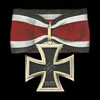
Hans-Joachim Jabs
Born in Lubeck in 1917, Jabs joined the Luftwaffe in 1937. Originally trained as a Messerschmitt Bf 109 pilot, Jabs was posted to Zerstörergeschwader 76 (ZG 76, flying the Messerschmitt Bf 110, in March 1940.
A member of II./ZG 76, Jabs operated over France in mid 1940, claiming four French aircraft and RAF fighters. He then flew over the British Isles during the Battle of Britain. Despite the vulnerability of the Bf 110 against the more nimble Royal Air Force (RAF) aircraft, and the heavy losses incurred, Jabs claimed eight Spitfires and four Hurricanes destroyed. By the end of the year Jabs was one of the top scoring Zerstörer (destroyer) pilots, with 16 victories.
In 1941 the majority of the Bf 110 units were withdrawn from daylight fighting, and Jabs was transferred to night fighting and Defense of the Reich. Retrained by October 1941, Jabs joined Nachtjagdgeschwader 3 stationed near Hamburg, protecting the port and Kriegsmarine installations. Opportunities for scoring remained elusive however, with just one more kill by June 1942. In November 1942 he transferred to IV./NJG 1. By January 1944 he had 45 kills to his credit, and in March 1944 became NJG 1 Geschwaderkommodore.
On 29 April 1944 his Bf 110-G night fighter was caught on a daylight air test by a flight of six Spitfires from No. 132 Squadron RAF, led by Squadron Leader Geoffrey Page (an ace with 15 kills). The Spitfires came in at too high a speed and Jabs shot down one Spitfire, flown by P/O R. B. Pullin, which went down in flames, killing the pilot. Another Spitfire flown by F/O J.J. Caulton then attacked Jabs head on, though the heavy forward armament of the 110 took effect and the stricken Spitfire glided around and belly-landed onto Deelen Air Base. Jabs then conducted a surprise forced landing, quickly scrambling for cover before his aircraft was destroyed by strafing.
Hans-Joachim Jabs was awarded the Knight's Cross of the Iron Cross with Oak Leaves (Eichenlaub zum Ritterkreuz des Einsernen Kreuzes) on 24 March 1944. He remained Kommodore of Nachjagdgeschwader 1 until the end of the war. He ended his career as an Oberstleutnant with 50 kills to his credit, 22 of these being day victories against Allied fighters technically far superior to his Bf 110. Jabs flew a total of 710 missions.
Asisbiz list of 49 aerial victories for Hans-Joachim Jabs
Date Pilot Name Unit Enemy A/C Type Height Time Location 12-May-40 Hans-Joachim Jabs 6./ZG76 Hawk-75A 07:15 13-May-40 Hans-Joachim Jabs 6./ZG76 Morane 18:50 15-May-40 Hans-Joachim Jabs 6./ZG76 Morane 14:25 29-May-40 Hans-Joachim Jabs 6./ZG76 Spitfire 14:05 29-May-40 Hans-Joachim Jabs 6./ZG76 Spitfire 2500m 14:10 Dunkirk 07-Jun-40 Hans-Joachim Jabs 6./ZG76 Morane 406 06:20 30-Aug-40 Hans-Joachim Jabs 6./ZG76 Hurricane 13:00 31-Aug-40 Hans-Joachim Jabs 6./ZG76 Spitfire 09:54 01-Sep-40 Hans-Joachim Jabs 6./ZG76 Hurricane 14:55 01-Sep-40 Hans-Joachim Jabs 6./ZG76 Spitfire 14:40 01-Sep-40 Hans-Joachim Jabs 6./ZG76 Hurricane 14:45 04-Sep-40 Hans-Joachim Jabs 6./ZG76 Spitfire 14:07 04-Sep-40 Hans-Joachim Jabs 6./ZG76 Spitfire 14:07 04-Sep-40 Hans-Joachim Jabs 6./ZG76 Hurricane 4000m 14:20 Tonbridge 07-Sep-40 Hans-Joachim Jabs 6./ZG76 Spitfire 5000m 19:20 South of London 11-Sep-40 Hans-Joachim Jabs 6./ZG76 Spitfire 5500m 17:20 S London 25-Jun-42 Hans-Joachim Jabs 9.NJG3 Stirling 5500m - - 26-Jul-42 Hans-Joachim Jabs 9.NJG3 Wellington 6200m - - 17-Dec-42 Hans-Joachim Jabs 11./NJG1 Halifax 1100m 22:46 434 4G 17-Dec-42 Hans-Joachim Jabs 11./NJG1 Stirling 50m 22:54 433 9 l 20-Dec-42 Hans-Joachim Jabs Stab I./NJG1 Wellington 3600m 20:13 5244 08-Jan-43 Hans-Joachim Jabs 11./NJG1 Halifax 2400m 22:15 446 9A in See 17-Jan-43 Hans-Joachim Jabs 11./NJG1 Stirling 3200m 22:17 544 5H1 in See 04-Feb-43 Hans-Joachim Jabs 11./NJG1 B-17 Fortress 10000m 12:51 545 5B7 19-Feb-43 Hans-Joachim Jabs 11./NJG1 Stirling 2500m 21:44 54/1/9F2 19-Feb-43 Hans-Joachim Jabs 11./NJG1 Stirling 1000m 21:00 54/4 8Z6 19-Feb-43 Hans-Joachim Jabs 11./NJG1 Stirling 1900m 21:18 54/6/3G2 09-Apr-43 Hans-Joachim Jabs 11./NJG1 Lancaster 1500m 23:56 443 3F 13-Jun-43 Hans-Joachim Jabs 11./NJG1 Lancaster 6200m 02:39 DL-71 (Wadenzee) 13-Jun-43 Hans-Joachim Jabs 11./NJG1 Lancaster 6500m 03:04 DK-62 (Texel) 22-Jun-43 Hans-Joachim Jabs 11./NJG1 Stirling 1800m 02:44 FK 32 23-Jun-43 Hans-Joachim Jabs 11./NJG1 Stirling 2700m 02:19 FK 15d 26-Jun-43 Hans-Joachim Jabs 11./NJG1 Halifax 5400m 02:35 FK 52 26-Jun-43 Hans-Joachim Jabs 11./NJG1 Halifax 4200m 02:40 EK 58 26-Jun-43 Hans-Joachim Jabs 11./NJG1 Lancaster 5000m 02:56 EL 86ga 28-Jul-43 Hans-Joachim Jabs 11./NJG1 Halifax 3000m 02:50 Ost CK-82h (off Vlieland) 03-Aug-43 Hans-Joachim Jabs Stab IV./NJG1 Stirling 2300m 03:29 Dl-26h (Waddenzee) 03-Aug-43 Hans-Joachim Jabs Stab IV./NJG1 Stirling 2100m 03:52 Raum Tiger 03-Aug-43 Hans-Joachim Jabs Stab IV./NJG1 Halifax 5500m 03:10 CL-29d 18-Oct-43 Hans-Joachim Jabs Stab IV./NJG1 Lancaster 5800m 20:07 Diepholz 03-Nov-43 Hans-Joachim Jabs Stab IV./NJG1 Lancaster 5800m 19:34 Gunzdorf 03-Nov-43 Hans-Joachim Jabs Stab IV./NJG1 Halifax 5800m 19:55 bei Niedermussen 28-Apr-44 Hans-Joachim Jabs Stab IV./NJG1 Lancaster 4500m 02:09 2km SE Diest 28-Apr-44 Hans-Joachim Jabs Stab IV./NJG1 Halifax 3800m 02:25 Rotterdam 29-Apr-44 Hans-Joachim Jabs Stab IV./NJG1 Spitfire 50m 15:15 3km S Valburg (SW Arnhem) 29-Apr-44 Hans-Joachim Jabs Stab IV./NJG1 Spitfire 50m 15:15 South of Apeldoorn 21-Jan-45 Hans-Joachim Jabs Stab IV./NJG1 Lancaster - - 20-Feb-45 Hans-Joachim Jabs Stab IV./NJG1 Lancaster - - 20-Feb-45 Hans-Joachim Jabs Stab IV./NJG1 Lancaster - -
Gerhard Kadow
Units: 5(J)/TrGr-186 (9/39 Stolp-Br�sterort), Flugzeugfuhrer in 6./ZG-1
Awards:
Known Aircraft: Bf 109B & E
Remarks: Jager Blatt 2/1998.
Heinrich (Heinz) Nacke
Units: Legion Condor, Stfkpt 6./ZG-76(7/39), Kdr III./NJG-3('43), Kdr II./ZG-1(5/43), Kdr ZG-1, NJG-101
Awards: RK(11/2/40), Spanish Cross-G, EK 1 & 2, Wound Badge, Night Fighter & Destroyer Oper. Clasps
Known Aircraft: Bf 110C, Ju 88, Bf 110G-2 WNr 6303 'S9+KM (dam 8/43), Fw 190A
Remarks: Night Fighter Pioneer. Kdr II/ZG-76 in August, 1941. Kdr ZG-101 in January, 1944, flying the Bf 110 & Ju88. Also served in (EKdo) ErprobungsKdo 25 in April, 1943, flying the Fw 190A. On 2 August, 1943, he suffered serious injuries in a crash in the G-2 on a delivery flight. The crash caused him to relinquish command of ZG-1. All his victories were in the West. One known victory, a Morane on 12 May, 1940, no location. This may have been his first. The next day, he downed two more Moranes in the Hirson area. Another Morane on 15 May, 1940. A Spitfire on 25 May, 1940. Two Spitfires over Dunkirk on 1 June, 1940. Another Spitfire in the Dunkirk area on 2 June, 1940. A Morane 406 on 22 June, 1940, no location. Nos.10 & 11, both Hurricanes in the Portland area on 15 August, 1940. Nos.13, 14 & 15, three Hurricanes, one over the Thames, on 30 August, 1940. Deceased 16 September, 1984 in Stuttgart.
Asisbiz Database of 14 aerial victories for Heinrich (Heinz) Nacke
Date Pilot Name Unit Enemy A/C Type Height Time Location Sunday, May 12, 1940 Heinz Nacke 6./ZG76 Morane 07:11 Monday, May 13, 1940 Heinz Nacke 6./ZG76 Morane 18:50 Monday, May 13, 1940 Heinz Nacke 6./ZG76 Morane 500m 18:50 Hirson Wednesday, May 15, 1940 Heinz Nacke 6./ZG76 Morane 14:25 Saturday, May 25, 1940 Heinz Nacke 6./ZG76 Spitfire 16:00 Saturday, June 01, 1940 Heinz Nacke 6./ZG76 Spitfire Dunkirk Saturday, June 01, 1940 Heinz Nacke 6./ZG76 Spitfire Dunkirk Sunday, June 02, 1940 Heinz Nacke 6/ZG76 Spitfire 09:40 Saturday, June 22, 1940 Heinz Nacke 6./ZG76 Morane 17:30 Thursday, August 15, 1940 Heinz Nacke 6./ZG76 Hurricane 18:40 Thursday, August 15, 1940 Heinz Nacke 6./ZG76 Hurricane 18:35 Friday, August 30, 1940 Heinz Nacke 6./ZG76 Hurricane 5600m 17:30 Thames Estuary Friday, August 30, 1940 Heinz Nacke 6./ZG76 Hurricane 12:50 Friday, August 30, 1940 Heinz Nacke 6./ZG76 Hurricane 12:40
Hans Peterburs
Units: III./ZG-76 (2/41), 1./ZG-1 (8/42 S.U.), III./ZG-1, II/SKG-210, Erg/SKG-10, II/SG-4
Awards: RK(11/25/42), For. Pilot wing, DK-G(5/4/42), EP(1/5/42), EK 1 & 2, Destroyer & Assault Oper.Clasps
Known Aircraft: Bf 110, Fw 190G-3 WNr 160370 'Yellow C' (lost 1/44 in II/SG-4)
Remarks: KIA 11 January, 1944 near Salerno when his Fw 190 was shot down by Spitfires. Channel pilot. Destroyed an additional 26 AC on the ground, as well as, 19 tanks. 5 aerial victories against British AC. His 1st known western victory, a Beaufort near Lister on 9 February, 1941. His first known Soviet victory, an I-153 on 30 August, 1942. Two I-16 Rata's on 10 October, 1942. Obermaier states that his brother, Heinz Peterburs, also a 'Jagdflieger' was killed in action, however I do not recognize him as a pilot.
Asisbiz Database of 4 aerial victories for Hans Peterburs
Date Pilot Name Unit Enemy A/C Type Height Time Location Sunday, February 09, 1941 Hans Peterburs III.ZG76 Beaufort - vor Lister Sunday, August 30, 1942 Hans Peterburs Stab II./ZG1 I-153 13:25 75 211 Saturday, October 10, 1942 Hans Peterburs Stab I./ZG1 I-16 Rata 09:30 1½km S Perewaling Saturday, October 10, 1942 Hans Peterburs Stab I./ZG1 I-16 Rata 09:25 95 582
Luftwaffe pilot Walter Nowotny 258 kills
Luftwaffe pilot Theodor Weissenberger 208 kills
Luftwaffe pilot Heinz Bar 175 kills
Luftwaffe pilot Franz Schall 133 kills
Luftwaffe pilot Rudolf Rademacher 126 kills
Luftwaffe pilot Adolf Galland 104 kills
Luftwaffe pilot Hermann Buchner 58 kills
Luftwaffe pilot Erich Hohagen 50 kills
Luftwaffe pilot Rudolf Sinner 39 kills
Luftwaffe pilot Ernst-Wilhelm Modrow 32 kills
Luftwaffe pilot Richard Altner 25 kills
Luftwaffe pilot Gunther Wegmann 21 kills
Luftwaffe pilot Wolfgang Schenck 18 kills
Luftwaffe pilot Franz Holzinger 10 kills
Luftwaffe pilot Helmut Lennartz 10 kills
Luftwaffe pilot Alfred 'Bubi' Schreiber 9 kills
Luftwaffe pilot Eduard Schallmoser 3 kills
Luftwaffe pilot Wilhelm Batel 1 kills
Luftwaffe pilot Joachim Fingerlos 1 kills
Bibliography: +
- Campbell, Jerry L. Messerschmitt BF 110 Zerstörer in Action. Carrollton, Texas: Squadron/Signal Publications, Inc., 1977. ISBN 0-89747-029-X.
- Caldwell, Donald and Richard Muller. The Luftwaffe over Germany: Defence of the Reich. London: Greenhill Books, 2007. ISBN 978-1-85367-712-0.
- Ciampaglia, Giuseppe. 'Destroyers in Second World War'. Rome: IBN editore, 1996. ISBN 88-86815-47-6.
- Deighton, Len. Fighter: The True Story of the Battle of Britain. London: Pimlico, 1996. ISBN 0-7126-7423-3.
- de Zeng, H. L., D. G. Stanket and E. J. Creek. Bomber Units of the Luftwaffe 1933-1945: A Reference Source, Volume 2. London: Ian Allan Publishing, 2007. ISBN 978-1-903223-87-1.
- Donald, David, ed. Warplanes of the Luftwaffe. London: Aerospace, 1994. ISBN 1-874023-56-5.
- Geust, Carl-Fredrik and Gennadiy Petrov. Red Stars Vol 2: German Aircraft in the Soviet Union. Tampere, Finland: Apali Oy, 1998. ISBN 952-5026-06-X.
- Hirsch, R.S. and Uwe Feist. Messerschmitt Bf 110 (Aero Series 16). Fallbrook, California: Aero Publishers, Inc., 1967.
- Hooton, E.R.Luftwaffe at War; Blitzkrieg in the West: Volume 2. London: Chervron/Ian Allan, 2007. ISBN 978-1-85780-272-6.
- Hooton, E.R. Luftwaffe at War; Gathering Storm 1933-39: Volume 1. London: Chervron/Ian Allan, 2007. ISBN 978-1-903223-71-0.
- Ledwoch, Janusz. Messerschmitt Bf 110 (Aircraft Monograph 3). Gdańsk, Poland: AJ-Press, 1994. ISBN 83-86208-12-0.
- Likso, T. and D. Canak. Hrvatsko Ratno Zrakoplovstvo u Drugome Svjetskom Ratu (The Croatian Airforce in the Second World War). Zagreb, 1998. ISBN 953-97698-0-9.
- Mankau, Heinz and Peter Petrick. Messerschmitt BF 110/Me 210/Me 410: An Illustrated History. Atglen, PA: Schiffer Publishing, 2003. ISBN 0-7643-1784-9.
- Murray, Willamson. Strategy for Defeat: The Luftwaffe 1935-1945. Maxwell AFB, Al: Air Power Research Institute, 1983. ISBN 0-16-002160-X.
- Mackay, Ron. Messerschmitt Bf 110. Wiltshire, UK: The Crowood Press, 2000. ISBN 1-86126-313-9
- Middlebrook, Martin. The Peenemunde Raid: The Night of 17-18 August 1943. Barnsely, UK: Pen & Sword Aviation, 2004. ISBN 1-84415-336-3.
- Munson, Kenneth. Fighters and Bombers. New York: Peerage Books, 1983. ISBN 0-907408-37-0.
- Price, Alfred. Messerschmitt Bf 110 Night Fighters (Aircraft in Profile No. 207). Windsor, Berkshire, UK: Profile Publications Ltd., 1971.
- Savic, Dragan and Boris Ciglic. Croatian Aces of World War II (Osprey Aircraft of the Aces - 49). London: Oxford, 2002. ISBN 978-1-84176-435-1.
- Treadwell, Terry C. Messerschmitt Bf 110(Classic WWII Aviation). Bristol, Avon, UK: Cerberus Publishing Ltd., 2005. ISBN 1-84145-107-X.
- Van Ishoven, Armand. Messerschmitt Bf 110 at War. Shepperton, Surrey: Ian Allan Ltd., 1985. ISBN 0-7110-1504-X.
- The Messerschmitt Bf 110 in Color Profile 1939-1945 John Vasco and Fernando Estanislau by Schieffer Publications. ISBN:0-7643-2254-0
- Wagner, Ray and Heinz J. Nowarra. German Combat Planes: A Comprehensive Survey and History of the Development of German Military Aircraft from 1914 to 1945. New York: Doubleday, 1971.
- Weal, John. Messerschmitt Bf 110 Zerstörer Aces World War Two. London: Osprey, 1999. ISBN 1-85532-753-8.
Magazine References: +
- Airfix Magazines (English) - http://www.airfix.com/
- Avions (French) - http://www.aerostories.org/~aerobiblio/rubrique10.html
- FlyPast (English) - http://www.flypast.com/
- Flugzeug Publikations GmbH (German) - http://vdmedien.com/flugzeug-publikations-gmbh-hersteller_verlag-vdm-heinz-nickel-33.html
- Flugzeug Classic (German) - http://www.flugzeugclassic.de/
- Klassiker (German) - http://shop.flugrevue.de/abo/klassiker-der-luftfahrt
- Le Fana de L'Aviation (French) - http://boutique.editions-lariviere.fr/site/abonnement-le-fana-de-l-aviation-626-4-6.html
- Le Fana de L'Aviation (French) - http://www.pdfmagazines.org/tags/Le+Fana+De+L+Aviation/
- Osprey (English) - http://www.ospreypublishing.com/
- Revi Magazines (Czech) - http://www.revi.cz/
Web References: +
- Wikipedia.org - https://en.wikipedia.org/wiki/Messerschmitt
 Editor for Asisbiz: Matthew Laird Acred
Editor for Asisbiz: Matthew Laird Acred
If you love our website please subscribe to our YouTube video channel
Please donate so we can make this site even better !!


